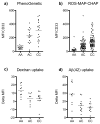CD33 Alzheimer's disease locus: altered monocyte function and amyloid biology
- PMID: 23708142
- PMCID: PMC3703870
- DOI: 10.1038/nn.3435
CD33 Alzheimer's disease locus: altered monocyte function and amyloid biology
Abstract
In our functional dissection of the CD33 Alzheimer's disease susceptibility locus, we found that the rs3865444(C) risk allele was associated with greater cell surface expression of CD33 in the monocytes (t50 = 10.06, P(joint) = 1.3 × 10(-13)) of young and older individuals. It was also associated with diminished internalization of amyloid-β 42 peptide, accumulation of neuritic amyloid pathology and fibrillar amyloid on in vivo imaging, and increased numbers of activated human microglia.
Figures



Comment in
-
Alzheimer disease: functional dissection of CD33 locus implicates innate immune response in Alzheimer disease pathology.Nat Rev Neurol. 2013 Jul;9(7):360. doi: 10.1038/nrneurol.2013.119. Epub 2013 Jun 18. Nat Rev Neurol. 2013. PMID: 23774859 No abstract available.
References
-
- Lambert JC, et al. Nature genetics. 2009;41:1094–1099. - PubMed
Publication types
MeSH terms
Substances
Grants and funding
- R01 AG17917/AG/NIA NIH HHS/United States
- U24 AG021886/AG/NIA NIH HHS/United States
- K25 AG041906/AG/NIA NIH HHS/United States
- R01 AG043617/AG/NIA NIH HHS/United States
- P30 AG008051/AG/NIA NIH HHS/United States
- R25 GM076321/GM/NIGMS NIH HHS/United States
- RC2 GM093080/GM/NIGMS NIH HHS/United States
- P50 AG005138/AG/NIA NIH HHS/United States
- R01 AG30146/AG/NIA NIH HHS/United States
- R01 AG011101/AG/NIA NIH HHS/United States
- R01 AG031553/AG/NIA NIH HHS/United States
- R01 AG015819/AG/NIA NIH HHS/United States
- R01 AG030146/AG/NIA NIH HHS/United States
- P50 AG008702/AG/NIA NIH HHS/United States
- P30 AG013846/AG/NIA NIH HHS/United States
- R10 NS067305/NS/NINDS NIH HHS/United States
- R01 AG017917/AG/NIA NIH HHS/United States
- P30 AG10161/AG/NIA NIH HHS/United States
- R01 NS067305/NS/NINDS NIH HHS/United States
- R01 AG036042/AG/NIA NIH HHS/United States
- R01 AG15819/AG/NIA NIH HHS/United States
- R01 AG11101/AG/NIA NIH HHS/United States
- P30 AG010161/AG/NIA NIH HHS/United States
LinkOut - more resources
Full Text Sources
Other Literature Sources
Medical

